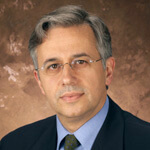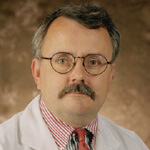
Researchers at the Health Science Center are another step closer to ending stroke for those most at risk.
Through a study called “Secondary Prevention of Small Subcortical Strokes” (SPS3), Oscar Benavente, M.D., associate professor of medicine in the division of neurology at the Health Science Center, and his colleague Robert Hart, M.D., professor of medicine in the division of neurology, are on a mission to prevent strokes in patients who have already had subcortical strokes. The study is funded by a $37 million grant from the National Institute of Neurological Disorders and Stroke (NINDS) of the National Institutes of Health (NIH). This is the largest single research grant in the Health Science Center’s history. The SPS3 is the first study of its kind in the world. Initiated with a pilot project in 1998, the study is now in Phase III with 50 clinical sites throughout the United States and Canada. The coordinating center is based in San Antonio. Within the next few months, the study will expand to include 20 additional sites throughout Mexico, Argentina, Ecuador, Chile and Spain.
According to Dr. Benavente, subcortical strokes are occurring at an alarming rate in Hispanics and blacks, and tend to be slightly more severe in those ethnic groups. “More than one-third of the ischemic strokes occurring in Hispanics in San Antonio are subcortical strokes,” Dr. Benavente said.

A subcortical stroke occurs when blood flow through the small arteries in the brain is blocked. According to the U.S. Centers for Disease Control and Prevention, about 700,000 people suffer a stroke every year. One-third of the victims are under the age of 65. Subcortical strokes, also called lacunar strokes, account for more than 27 percent of all ischemic strokes (the most common type of stroke).
Although subcortical strokes are usually not fatal, they strike again, putting victims at risk for disabling side effects, including dementia and paralysis.
Drs. Benavente and Hart and their research team are seeking to learn if a combination of aspirin and an anti-clotting agent called clopidogrel is more effective than aspirin alone for preventing recurrent strokes. Along with Pablo Pergola, M.D., Ph.D., associate professor of medicine, who is leading the hypertension component of the trial, they also are seeking to learn whether or not intensive blood pressure control is associated with fewer recurrent strokes. Their goal is to enroll 2,500 study participants who will be monitored for 3.5 years.
Study participants are randomly assigned to one of two types of treatment – either aspirin alone or the combination of aspirin and clopidogrel. Participants with hypertension are randomly assigned to one of two groups of blood pressure control – below 130 mmHg of systolic pressure or between 130 and 149 mmHg. All medications and clinic visits are free to study participants. Participants also receive a tailored diet and exercise plan, healthy recipes and meal plans, free transportation and home visits if needed, and a 24-hour-a-day emergency hotline.
Through the SPS3, Drs. Benavente and Hart and their research team continue to help stroke survivors across the globe prevent a second attack from devastating their lives.
The SPS3 study is enrolling patients who are 40 or older and who have had a subcortical stroke. For more information and study guidelines, call (210) 592-0404.

